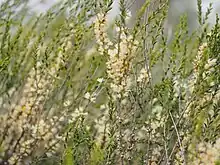| Mallee honeymyrtle | |
|---|---|
 | |
| Scientific classification | |
| Kingdom: | Plantae |
| Clade: | Tracheophytes |
| Clade: | Angiosperms |
| Clade: | Eudicots |
| Clade: | Rosids |
| Order: | Myrtales |
| Family: | Myrtaceae |
| Genus: | Melaleuca |
| Species: | M. acuminata |
| Binomial name | |
| Melaleuca acuminata | |
| Synonyms[1] | |
Melaleuca acuminata, commonly known as mallee honeymyrtle is a plant in the myrtle family, Myrtaceae and is native to Australia and widespread in temperate areas of the continent. It is an erect shrub to about 3 m (9.8 ft) usually found in mallee woodland.
Description
Melaleuca acuminata is an erect, rather open shrub with papery or fibrous bark and many ascending branches. The leaves are in alternating pairs on either side of the stem (decussate), narrow elliptic in shape, 5–10 mm (0.2–0.4 in) long, 2–4 mm (0.08–0.2 in) wide with a short petiole.[2][3][4][5]
.JPG.webp)

The flowers are cream or white, sometimes tinged with pink and are in cluster of three to six, the clusters occurring along the stem over a considerable length. The stamens are grouped into five clusters or "claws" and there are 9 to 17 stamens per claw. Flowering occurs in spring and is followed by fruit which are smooth, woody capsules, 3–5 mm (0.1–0.2 in) diameter borne singly or in small clusters.[2][3][4][5]
Taxonomy and naming
Melaleuca acuminata was first described in 1858 by Ferdinand von Mueller in Fragmenta Phytographiae Australiae from a specimen found "in the stony hills of Mount Barker Creek by L. Fischer".[6][7] The specific epithet (acuminata) is from the Latin acumen, meaning "sharp point" referring to the leaf tips.[5]
In 1920, Spencer Le Marchant Moore described Melaleuca websteri in the Journal of the Linnean Society, Botany,[8][9] but in 1999, Lyndley Craven and Brendan Lepschi reduced it to a subspecies of M. accuminata as subspecies websteri (S.Moore) Barlow ex Craven. The name, and that of the autonym are accepted by Plants of the World Online:[1]
- Melaleuca acuminata F.Muell. subsp. acuminata occurs in Western Australia, South Australia, Victoria and the south–west of New South Wales.[10]
- Melaleuca acuminata subsp. websteri (S.Moore) Barlow ex. Craven has narrower leaves, the flowers with a shorter hypanthium and is restricted to Western Australia.[10] The subspecies name (websteri) honours Leonard Clarke Webster, an Australian botanical collector and later a doctor.[5][11]
Distribution and habitat
Mallee honeymyrtle occurs in Western Australia in the Carnarvon, Coolgardie, Avon Wheatbelt, Esperance, Jarrah Forest and Mallee biogeographic regions;[12][13] in South Australia it is found in the far south-east corner of the state;[14] in western Victoria, in the Murray Mallee, Lowan Mallee, Wimmera, Goldfields and Greater Grampians biozones,[15] and in New South Wales it is rare and found only in the Balranald district.[3] It grows in mallee communities on sandhills in New South Wales or elsewhere, in sandy or clayey soils in swampy depressions or rises, often in saline conditions.
Conservation status
This species is classified as "not threatened" by the Government of Western Australia Department of Parks and Wildlife.[13]
Use in horticulture
This melaleuca is adaptable and easy to grow[2] and when well supplied with water grows more vigorously than usually seen in the wild.[16]
See also
References
- 1 2 3 "Melaleuca acuminata". Plants of the World Online. Retrieved 23 August 2021.
- 1 2 3 Holliday, Ivan (2004). Melaleucas : a field and garden guide (2nd ed.). Frenchs Forest, N.S.W.: Reed New Holland Publishers. pp. 80–81. ISBN 1876334983.
- 1 2 3 "Melaleuca acuminata". Royal Botanic Gardens, Sydney. Retrieved 4 March 2015.
- 1 2 Corrick, Margaret; Fuhrer, Bruce Alexander (2009). Wildflowers of southern Western Australia (3rd ed.). [Kenthurst, N.S.W.]: Rosenberg Pub. p. 132. ISBN 9781877058844. Retrieved 4 March 2015.
- 1 2 3 4 Brophy, Joseph J.; Craven, Lyndley A.; Doran, John C. (2013). Melaleucas : their botany, essential oils and uses (PDF). Canberra: Australian Centre for International Agricultural Research. pp. 66–67. ISBN 9781922137517. Retrieved 30 August 2015.
- ↑ "Melaleuca acuminata". APNI. Retrieved 6 June 2015.
- ↑ von Mueller, Ferdinand (1858). Fragmenta Phytographiae Australiae (Volume 1). Melbourne. p. 15. Retrieved 30 August 2015.
{{cite book}}: CS1 maint: location missing publisher (link) - ↑ "Melaleuca websteri". APNI. Retrieved 23 August 2021.
- ↑ Le Marchant Moore, Spencer (1920). "A Contribution to the Flora of Australia". Journal of the Linnean Society, Botany. 45: 204. Retrieved 23 August 2021.
- 1 2 Craven, Lyndley A.; Lepschi, Brendan J. (1999). "Enumeration of the Species and Infraspecific Taxa of Melaleuca (Myrtaceae) occurring in Australia and Tasmania". Australian Systematic Botany. 12 (6): 858. doi:10.1071/SB98019.
- ↑ "Webster, Leonard Clarke (1870 - 1942)". Australian National Botanic Garden. Retrieved 30 August 2015.
- ↑ Paczkowska, Grazyna; Chapman, Alex R. (2000). The Western Australian flora : a descriptive catalogue. Perth: Wildflower Society of Western Australia. p. 391. ISBN 0646402439.
- 1 2 "Melaleuca acuminata". FloraBase. Retrieved 29 April 2015.
- ↑ Carrick, J.; Chornley, K. (1979). "A review of Melaleuca L. (Myrtaceae) in South Australia" (PDF). Journal of the Adelaide Botanic Gardens. 1 (5): 281–319. Archived from the original (PDF) on 24 September 2015. Retrieved 4 March 2015.
- ↑ "Melaleuca acuminata". Royal Botanic Gardens, Melbourne. Retrieved 4 March 2015.
- ↑ Wrigley, John W.; Fagg, Murray (1983). Australian native plants : a manual for their propagation, cultivation and use in landscaping (2nd ed.). Sydney: Collins. pp. 260–261. ISBN 0002165759.